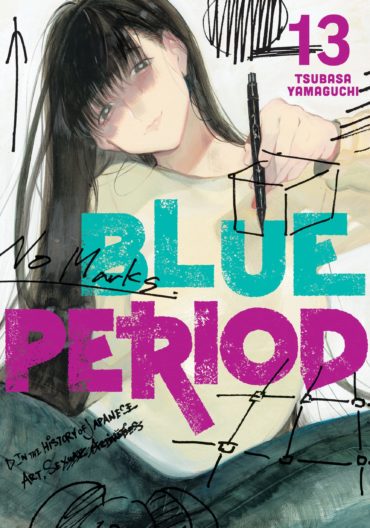Blue Period Volume 13 Review
“I really am a self-serving flip-flopper.” Yatora. “…if I hadn’t gone to No Marks… I don’t think I would have been motivated to engage with art again.”
‘Guilt’: the assignment set by the cold and harshly critical Professor Inukai, has driven Yatora further away from the stifling atmosphere of TUA into No Marks, a colony of artists led by the charismatic and accepting Kirio Fuji (pictured on the cover). After spending time in her company, Yatora is feeling a lot less confused and jaded. He knows exactly what he wants to create for his assignment. He returns, constructs his piece and, alongside his fellow students, awaits (in quiet trepidation) the arrival of the professors to assess what he has done.
When it’s all over and Yatora returns to No Marks, he finds the building empty; the members are moving on. Fuji-san appears and tells him, “When the new No Marks is ready, come and hang out whenever you want. Because the door will probably always be open.” And then she’s driven away. We can only guess how Yatora feels. It’s impossible not to think that he’s had a crush on her, especially as she’s helped him discover more about what he wants to do as an artist.
Hanging out with his fellow students at TUA over summer break, Yatora (now twenty) is swept up in a visit to Momo-chan’s family home alongside Yakumo and Yotasuke – which turns out to be a temple! (Momo-chan is his diminutive classmate with the pink plaits who is a massive fan of sumo wrestling – and so, it turns out, is her father who runs the temple.) There’s a vast studio in the temple compound and this is where the students can make big pieces of art (Yakumo’s speciality). So it turns into a kind of a light-hearted working holiday… until Yakumo drops the name ‘Sanada’ into the conversation over beers. But when Yatora, curious, asks for more information, Yakumo’s answer shocks him (and us).
What is the very special magic that Tsubasa Yamaguchi brings to Blue Period that makes it still so readable and engrossing, even after thirteen volumes? Yatora Yaguchi, first and foremost, her viewpoint character. His struggles to find his identity as an artist are still very relatable, even if you’re not an arts student. His encounters with hostile and unhelpful lecturers, sympathetic fellow-students and all kinds of other influences during his undergraduate years at TUA are realistically and believably portrayed. Especially when he doesn’t get things right and loses his way, a state of mind that anyone who’s worked in the creative arts will recognize. Then there’s her unique and characterful graphic style which encompasses everything from her delightful chibi versions for the lighter moments like the yon-koma at the end, to the crucial scenes of high tension, especially Professor Inukai’s assessment, where it’s hard not to feel as nervous as the waiting students as you turn the pages. It makes sense that a series about making art should be playful and experimental with art techniques to convey its story and Yamaguchi has never held back, as well as still occasionally employing works by her friends and art students to represent the work of Yatora’s contemporaries.
We’ve now almost caught up with Japan; Volume 14 came out in July (2023) but won’t be available in English until March 2024. Disappointingly, this volume has no colour pages (the mangaka’s colour work is always a treat) but there’s a fun ‘extra comic’ at the end: The Daily Routine of the TAs. This takes the reader inside the world of the TUA Teaching Assistants and the sometimes difficult path they have to tread between the students and the professors. Ajani Oloye is the translator again and, as always, provides a very readable translation as well as useful and interesting translation notes at the end.


